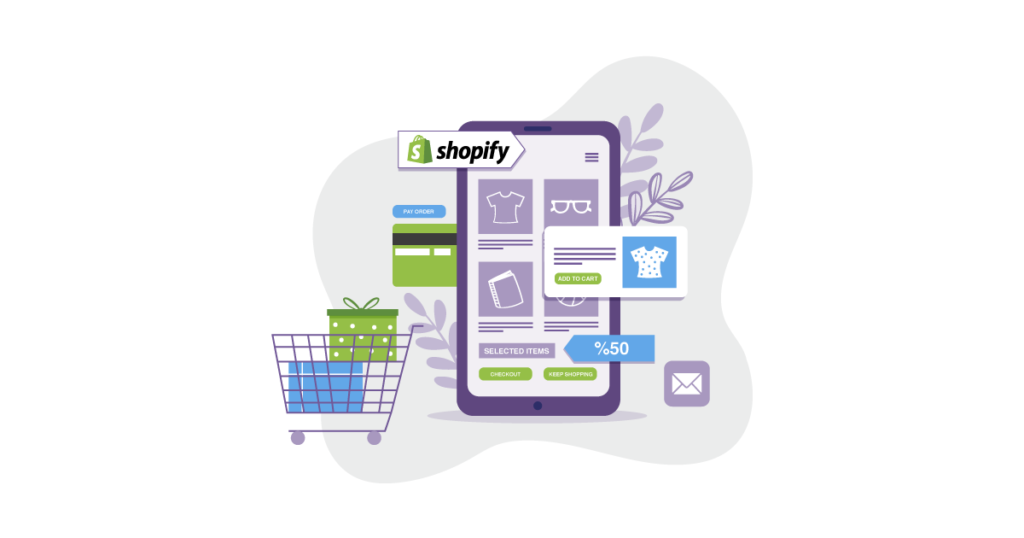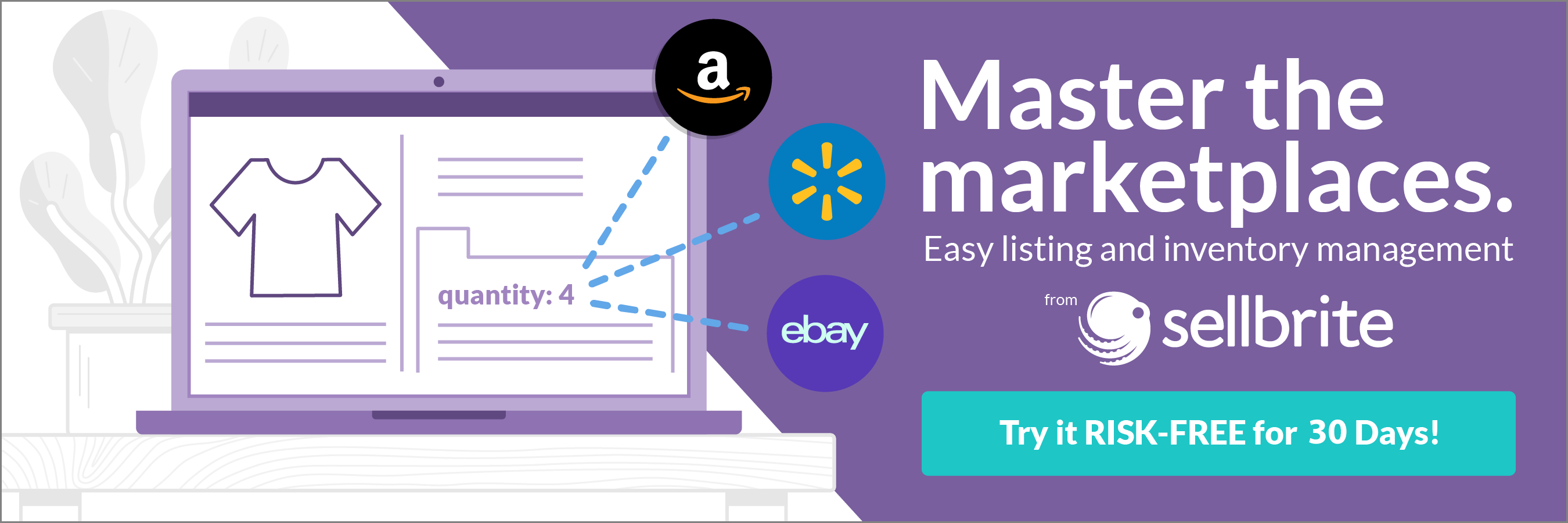Shopify is great for easily setting up an online store, but if you’re not utilizing Shopify integrations, you’re leaving a lot of opportunities on the table.
The base Shopify experience is designed to be simple. At most price points, you get an online store, unlimited product listings, inventory tracking, and shipping, plus a few other features like an SSL certificate and customer service options. However, Shopify is a modular platform — you can add as much complexity and as many bells and whistles as you’d like through both first- and third-party apps.
We’re going to guide you through the Shopify integrations that can transform your store, boost sales, and improve your marketing efforts across different channels.
1. Yotpo: Add Customer and Product Reviews to Your Store
Yotpo is an app that integrates with Shopify to engage your customers not only by facilitating product review but also by helping you create loyalty and rewards programs. Seventy-two percent of customers will wait to read reviews before making a purchase.
Your Shopify store needs customer reviews: not only do they increase sales by 18% and increase potential conversions by 270%, but they also add SEO value with user-generated content. Think about it: product reviews tend to mention the product itself and related keywords. Reviews also represent a steady flow of fresh content that doesn’t take up any of your time to build.

Yotpo Features
Yotpo’s “Reviews and Ratings” Shopify app allows your ecommerce customers to leave reviews of your products and services from a computer or mobile device.
Reviews and ratings: Yotpo doesn’t just allow customers to create reviews; it also encourages them to do so with follow-up emails. Asking for reviews works, too: a BrightLocal survey found that 76% of customers who were asked to leave a review did so. These reviews can then be displayed wherever you like on your Shopify store: on the main page, the individual product pages, or the category pages.
Encouraging reviews: You can create coupons that encourage reviews and send them right to your buyers, and you can even customize the questions you ask your customers instead of just relying on a blank text field for them to fill.
Where to get it: You can try a demo on their main site or download the app from the Shopify app store.
2. Privy: Boost Conversions and Marketing
An online store without effective marketing is dead in the water; integrating your Shopify store with Privy can increase awareness and sales. Privy specializes in reengaging customers who may have drifted off through disinterest, lack of information, or buyer hesitation.

Privy Features
Mailing list pop-ups: Engaging customers long-term over email is crucial. Data in 2019 shows that ROI for each dollar spent on email marketing is $50. Privy allows you to add pop-ups to your Shopify store that encourage customers to provide their email, usually to receive special offers in the future.
Automated newsletters: Privy has newsletter features to go with its mailing-list collection service. Privy lets you customize your own newsletter template, which can be automated and sent via email or text.
Abandoned cart outreach: Privy sends follow-up emails and alerts when a customer comes close to checking out at your Shopify store but backs out. Like the newsletters, these messages are automated but can be customized, both in content and in frequency. They can offer additional information to the customer, furnish them with product reviews to overcome hesitation, and/or offer deals or discounts on the products they almost bought.
Where to get it: Privy’s Pop Ups, Email, & SMS app for Shopify integration can be found in the Shopify app store.
3. Printful: Create Print-On-Demand Merch
Printful allows you to create designs for T-shirts, mugs, backpacks, tote bags, and other accessories and sell that on-demand merch in your Shopify store. No matter what product you’re selling on Shopify, there’s always room for branded merchandise.
For instance, John Deere might focus on making tractors, but their merchandising arm is quite robust. This keeps customers’ minds on the product even when they’re not interacting with the actual business in any way.
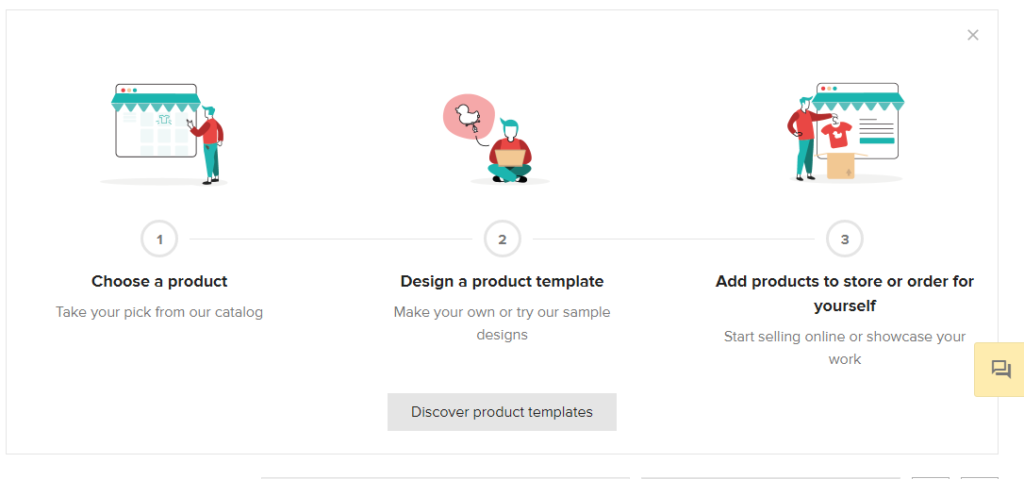
Printful Features
Sell on-demand custom products: You can then print and sell branded products, such as shirt, leggings, phone cases, pillows, posters, and face masks, just to name a few. Printful is also print-on-demand, meaning you won’t have to commit to a bulk order (and subsequent storage) just to create a little merch.
Printful is quick to set up: you’re walked through store creation, which you can sync with Shopify. Any products you create are pushed to your Shopify store, along with product information, such as descriptions, mockup photos, live shipping rates, and inventory status.
Design your own merch: Hiring a designer is never a bad idea, but you can create your own designs on Printful with their customization tool. You can add text in multiple different fonts, with a choice of text color, size, outline, rotation, and shadow. You can upload graphics as well, and put both graphics and text on the same product. Their Mockup Generator then pastes your design onto photos of the product (often being worn/carried by models), giving you a better feel for your design in advance.
Where to get it: Log in to Printful, create an account, and sync it with your Shopify right from your Printful dashboard.
4. Now Back in Stock: Regain Potential Customers
“Now Back in Stock” (NBIS) is an app that integrates with Shopify to both track your inventory and notify shoppers when that coveted item is back in stock.
Customers who are excited about a product and have their wallet in hand can’t convert if you’re out of inventory. When customers see that “out of stock” warning and wander off to greener pastures, there’s no guarantee they’ll ever get back to your site to check for inventory updates.
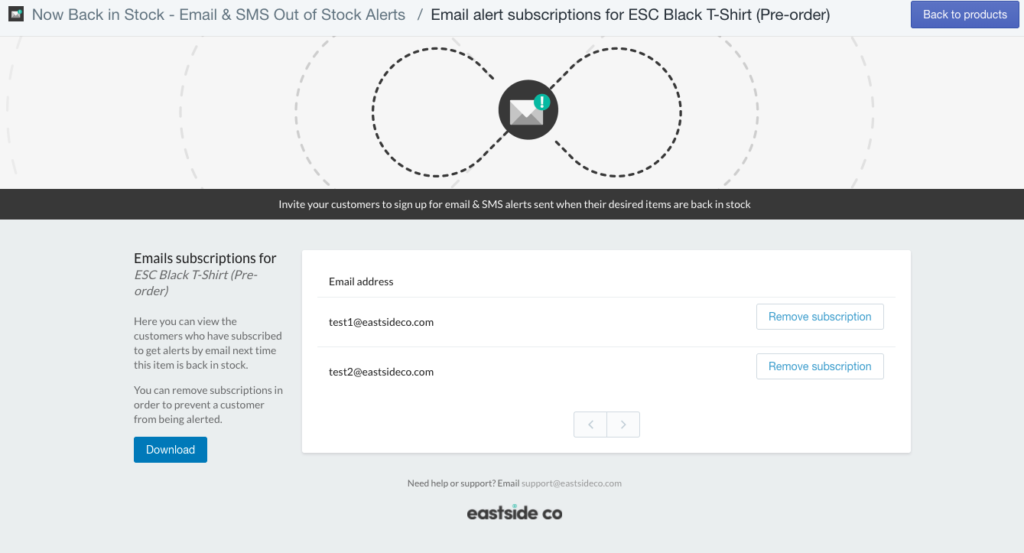
Now Back In Stock Features
Back in stock alerts: NBIS sends email, SMS, or push alerts to customers who tried to add a product to their cart, only to discover the item was out of stock. These alerts get sent when the item in question is back in stock, giving them a second chance to buy.
Variant stock alerts: These alerts even cover variants of the items they were looking for. If the item in question wasn’t out of stock but the “red” version of it was, would-be customers will get a notification that the version they wanted is back. (Obviously, the customer gets to opt in to these alerts.)
Greater communication: Not only does this benefit you in the short term, but your customer has now opted in to receiving information from you as well, expanding your newsletter options and your communication channels.
Where to get it: You can activate “Now Back in Stock” through the Shopify app store.
5. Bold Sales Motivator: Offer Deals, Gifts, and Free Shipping
Customers buy your product and leave your ecommerce store — no problems there. However, you can increase the value of your average order by letting customers know what they’d need to buy or add to their cart to get a little something extra.
Bold Sales Motivator informs your customers how close they are to special deals and it’s one of the top Shopify integrations.
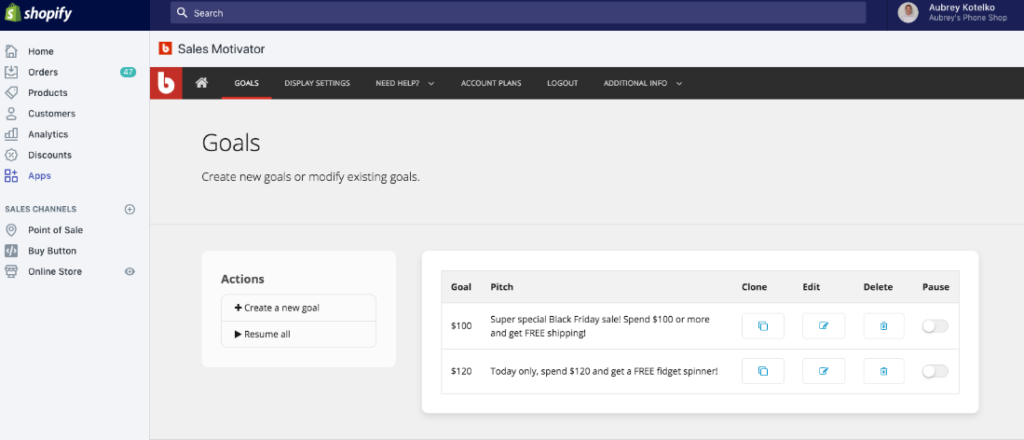
Bold Sales Motivator Features
The goal of Bold Sales Motivator is to get customers spending more, but not by tricking them. Instead, Bold Sales Motivator helps you and customers add real value to Shopify orders.
Free gifts: Encourage extra spending by offering free gifts that add to the cart when the customer spends a certain amount. This is a great way to move small or relatively low-value products while encouraging the customer to spend more and feel like they’ve earned a treat.
Free shipping: Customize your own shipping thresholds. Does spending $50 or $100 entitle customers to free shipping? That’s up to you, but the app will take care of all the behind-the-scenes calculation and notification. Customers will see relevant prompts when they’re within swinging distance of the threshold that will encourage them to add an extra item or two to their cart.
Geographically specific promotions: Blanket “free shipping” could come back to bite you if you do international business. Bold Sales Motivator lets you use a geo-fencing feature to ensure that any promotions or offers are financially and legally prudent, considering the customer’s area and location.
Where to get it: Grab Bold Sales Motivator from the Shopify app store. The app is free for two weeks, after which it costs $9.99 per month.
6. Sellbrite: Sync Your Listings Across Multiple Channels
Do you want to sell on ecommerce sites like Amazon but manage all of your inventory and orders from Shopify? Sellbrite for Shopify can integrate your products (and data) across multiple retail channels with little effort on your part.

Sellbrite for Shopify Features
Keep your shipping methods: Instead of dealing with Amazon’s and eBay’s and Walmart’s shipping systems, Sellbrite for Shopify allows you to keep your current shipping strategy. Whatever you were using for your Shopify store will remain consistent, no matter the marketplace or platform your listing is on.
Sync data globally: When you integrate Sellbrite for Shopify with your Shopify store and begin selling on multiple marketplaces, you won’t have to manage the data across every channel. Any changes to product data, prices, or listing details will populate across all linked marketplaces.
Leverage huge marketplaces: Your Shopify store will be listed in some of the largest ecommerce marketplaces in the world. Take Amazon, for example: a 2019 study shows that 89% of the 2,000 polled are more likely to buy a product on Amazon than anywhere else. Linking your Shopify account to Amazon, for instance, creates an automatic increase in audience and potential customer base.
Where to get it: You can get a free trial at Sellbrite’s website, after which the service will cost $19 a month.
7. ShopSync: Integrate Mailchimp and Shopify
Shopify doesn’t natively support integrations with every app, but there’s plenty of third-party software that can make seemingly incompatible programs play well together. Mailchimp recently split with Shopify, shutting down official integration between both apps.
This has put a number of ecommerce owners in a rough spot: Mailchimp is by far the most popular automated marketing software. One could even argue that it’s synonymous with newsletter marketing campaigns for businesses. So for Shopify retailers who worry about losing their primary email marketing tool, “ShopSync” is a third-party app that can integrate Mailchimp and Shopify again.

Sync Your Mail Features
Collect emails from customers: ShopSync can create pop-ups that collect email from customers and send them to your Mailchimp account, which will then organize that data and make it available for your marketing campaigns.
Sync all contacts: ShopSync will make Shopify and Mailchimp contacts play well together again, syncing any contacts you gain on either platform across both.
Track ecommerce data: All data from sales and customer segments will go from Shopify to Mailchimp for further analysis and use. Target demographics, track spending habits, and analyze purchase trends over time.
Marketing and remarketing: Shopsync will track customer behavior on Shopify and allow Mailchimp to offer promo codes to hesitant buyers, remarket to lost customers, and send order notifications to customers.
Where to get it: ShopSync is available on the Shopify app store for free.Don’t Settle for the Basics
Don’t Settle for the Basics — Use Shopify Integrations
Shopify is simple to set up and easy to use, much to its credit. However, Shopify was also designed from the ground up to be modular to allow you to “plug and play” new features to customize your store, your shopping experience, and your marketing efforts.
You don’t have to install every single one of these apps — in fact there is some overlap — but giving some of their features a try is highly recommended. These Shopify integrations can increase the effectiveness of your marketing, help you manage your products, provide value to your customers, and let you list your products on the largest global marketplaces online.
Many of these services come with free trials. Give them a spin and see if they level up your ecommerce store.
